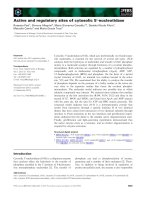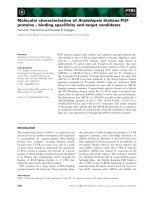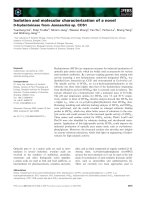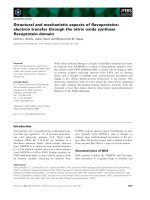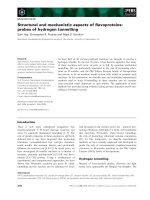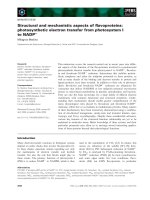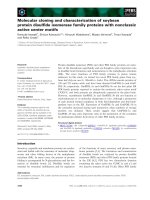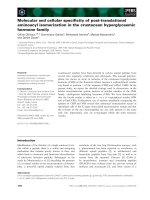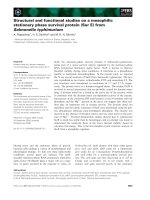Tài liệu Báo cáo khoa học: Molecular and functional characterization of adenylate kinase 2 gene from Leishmania donovani pdf
Bạn đang xem bản rút gọn của tài liệu. Xem và tải ngay bản đầy đủ của tài liệu tại đây (533.33 KB, 9 trang )
Molecular and functional characterization of adenylate kinase 2
gene from
Leishmania donovani
He
´
ctor Villa
1
, Yolanda Pe
´
rez-Pertejo
1
, Carlos Garcı
´
a-Estrada
1
, Rosa M. Reguera
1
, Jose
´
Marı
´
a Requena
2
,
Babu L. Tekwani
3
, Rafael Balan
˜
a-Fouce
1
and David Ordo
´
n
˜
ez
1
1
Departamento de Farmacologı
´
a y Toxicologı
´
a (INTOXCAL), Facultad de Veterinaria, Universidad de Leo
´
n, Spain;
2
Centro de
Biologı
´
a Molecular ‘Severo Ochoa’, Universidad Auto
´
noma de Madrid, Spain;
3
National Center for Natural Products Research,
School of Pharmacy, University of Mississippi, USA
ATP-regenerating enzymes may have an important role in
maintaining ATP levels in mitochondria-like kinetoplast
organelle and glycosomes in parasitic protozoa. Adenylate
kinase (AK) (ATP:AMP phosphotransferase) catalyses the
reversible transfer of the c-phosphate group from ATP to
AMP, releasing two molecules of ADP. This study describes
cloning and functional characterization of the gene encoding
AK2 from a genomiclibrary of Leishmania donovani and also
its expression in leishmania promastigote cultures. AK2 was
localized on an 1.9-Mb chromosomal bandas a single copy
gene. L. donovani AK2 gene is expressed as a single 1.9-kb
mRNA transcript that is developmentally regulated and
accumulated during the early log phase. The overexpression
of L. donovani AK gene in Escherichia coli yielded a 26-kDa
polypeptide that could be refolded to a functional protein
with AK activity. The recombinant protein was purified to
apparent homogeneity. Kinetic analysis of purified
L. donovani AK showed hyperbolic behaviour for both ATP
and AMP, with K
m
values of 104 and 74 l
M
, respectively.
The maximum enzyme activity (V
max
) was 0.18 lmolÆmin
)1
Æ
mg
)1
protein. P
1
,P
5
-(bis adenosine)-5¢-pentaphosphate
(Ap
5
A), the specific inhibitor of AK, competitively inhibited
activity of the recombinant enzymes with estimated K
i
values
of 190 n
M
and 160 n
M
for ATP and AMP, respectively.
Ap
5
A also inhibited the growth ofL. donovani promastigotes
in vitro which could be only partially reversed by the addition
of ADP. Thus, presence of a highly regulated AK2, which
may have role in maintenance of ADP/ATP levels in
L. donovani, has been demonstrated.
Keywords: adenylate kinase; functional expression; leish-
mania.
Adenylate kinase (AK) (ATP:AMP phosphotransferase,
EC 2.7.4.3) catalyses the reversible transfer of the c-phos-
phate group from ATP to AMP, releasing two molecules of
ADP [1]. Different isoenzymic forms of AK are involved in
maintenance of constant intracellular levels of adenine
nucleotides, necessary for energy metabolism and nucleic
acid synthesis [2]. Three AK isoforms have been described in
mammals: AK1 in the cytosol, AK2 in the mitochondrial
intermembrane space [3] and AK3, a GTP:AMP phospho-
transferase that resides exclusively in the mitochondrial
matrix [4].
The role of AKs in the organisms of the order Kineto-
plastida (that includes trypanosomes, leishmanias and other
pathogenic parasites) has not been studied in detail yet. As
in their mammalian hosts, AK in these parasites seems to be
distributed in several intracellular compartments. These
eukaryotic microorganisms have some characteristic sub-
cellular organelles, such as modified mitochondria called
ÔkinetoplastsÕ and several specific energy-producing micro-
bodies called ÔglycosomesÕ [5]. AK plays an important role in
the ATP-regenerating system required for eukaryotic ciliary
or flagellar movements and has been found to be associated
with Tetrahymena cilia [6], Paramecium caudatum [7] as well
as vertebrate spermatozoid flagella [8,9]. AK activity in
Leishmania promastigotes and Trypanosoma spp. has been
found to be associated with the membrane of glycosomes
[10,11]. A third form of AK located in the cytosol has been
proposed as a virulence factor in bacteria, as it is secreted
along with other ATP-related enzymes, contributing to
modulation of ATP levels during macrophage death [12,13].
Structural studies with AKs from different sources have
revealed the presence of three distinct domains: the rigid
CORE-domain and two smaller peripheral domains or
mobile parts, the NMP-binding site and the LID-domain
[4]. The NMP-binding site has many intermolecular
contacts with the nucleotide phosphoryl acceptor (NMP),
whereas the LID-domain prevents the hydrolysis of the
Mg-bound phosphoryl donor in the active site. The relative
movement of the NMP-binding site and LID-domain
Correspondence to D. Ordo
´
n
˜
ez, Department Farmacologı
´
ayToxi-
cologı
´
a (INTOXCAL), Ftad. Veterinaria, Universidad de Leo
´
n,
Campus de Vegazana s/n 24071 Leo
´
n, Spain.
Fax: + 34 987 291 252, Tel.: + 34 987 291 590,
E-mail:
Abbreviations: AK, adenylate kinase; IPTG, isopropyl thio-b-
D
-
galactoside; Ap
5
A, P
1
,P
5
-bis(adenosine)-5¢-pentaphosphate; NMP,
nucleoside monophosphate; IC
50
, 50% inhibitory concentration.
Enzymes: adenylate kinase (ATP:AMP phosphotransferase;
EC 2.7.4.3).
Note: The nucleotide sequence data reported has been submitted to
EMBL and GenBank Nucleotide Sequence Databases under the
accession number AF156853.
(Received 14 May 2003, revised 25 July 2003,
accepted 9 September 2003)
Eur. J. Biochem. 270, 4339–4347 (2003) Ó FEBS 2003 doi:10.1046/j.1432-1033.2003.03826.x
induced by the substrates leads to two conformations called
ÔclosedÕ and ÔopenÕ states, which have been thoroughly
described by Schulz et al. [14]. Genes encoding AKs have
been characterized in many organisms, including bacteria,
fungi and mammals. There are no reports about character-
ization of this enzyme in parasitic protozoa. Leishmania
donovani is the aetiological agent for visceral leishmaniasis, a
devastating disease which is mostly endemic in Asian and
Mediterranean countries [15]. This paper describes the
cloning and functional characterization of an AK gene from
a genomic library of L. donovani as well as its expression
and molecular characterization.
Materials and methods
Materials
Plasmids pGEM-3Zf(+) and pQE30 were from Promega
and QIAGEN, respectively. [
32
P]dCTP[aP] (3000 CiÆ
mmol
)1
) was from DuPont-NEN. Restriction enzymes
and Taq DNA polymerase were from Boehringer Mann-
heim. Isopropyl thio-b-
D
-galactoside (IPTG), pyruvate
kinase, lactate dehydrogenase, phosphoenolpyruvate, pro-
teinase K, antibiotics, ATP, AMP, dithiothreitol and P
1
,P
5
-
bis(adenosine)-5¢-pentaphosphate (Ap
5
A) were from Sigma.
Lambda EMBL-3 genomic library was a gift from
J.C. Meade (University of Mississippi, Medical Center,
MS, USA).
Parasite cell culture
Promastigote cultures of L. donovani 1S2D strain (a gener-
ous gift from L. Rivas, Centro de Investigaciones Biolo
´
gicas
CSIC, Madrid, Spain) were grown at 26.5 °C in M199
medium (Sigma) supplemented with sodium bicarbonate,
5m
M
Hepes, heat inactivated foetal bovine serum (10%)
(Boehringer Mannheim) and gentamicin (30 lgÆmL
)1
)
(Sigma).
Nucleic acid isolation
Genomic DNA from L. donovani promastigotes was isola-
ted from 2.0 · 10
9
cells in 10 m
M
EDTA, 150 m
M
NaCl,
0.4% SDS, 50 mgÆmL
)1
proteinase K and incubated at
65 °C for 1 h followed by an overnight incubation at 37 °C.
The DNA was further purified by phenol/chloroform
extraction and ethanol precipitation. RNA was isolated
with RNAeasy kit (QIAGEN) according to manufacture’s
protocol.
Isolation of a
L. donovani
AK gene fragment by PCR
To generate a DNA probe for the isolation of the
L. donovani AK gene, PCR was carried out using degenerate
oligonucleotides based on conserved amino acid sequences
in human AK type 2A [16], Saccharomyces cerevisiae [17],
Trichomonas vaginalis [18], Oryza sativa [19] and Escherichia
coli [20] AK proteins. The sense primer (5¢-GACGG
TTTTCCGCGCAC-3¢) corresponding to the amino acid
residues DGFPRT and an antisense primer (5¢-ACCAGG
GGCTCGCCGGT-3¢) corresponding to amino acid resi-
dues TGEPLV were used for isolation of AK gene fragment
by PCR with L. donovani genomic DNA. The PCR product
was sequenced on both strands by an ALF automated
sequencer (Sistemas Geno
´
micos, Valencia, Spain) according
to the dideoxy chain termination method using fluorescent
primers and T7 DNA polymerase.
Isolation of
L. donovani AK
gene
The EMBL L. donovani library was used for screening.
50 000 bacteriophages were blotted onto positively charged
nylon membranes (Amersham) and prehybridized for 4 h at
42 °Cin5· Denhardt’s solution, 5 · NaCl/Cit, 50 m
M
sodium phosphate (pH 6.5), 100 lgÆmL
)1
salmon sperm
DNA, and 50% formamide. Membranes were hybridized
for 16–20 h at 42 °C in the same buffer containing
10
6
)10
7
c.p.m. of
32
P-labelled 215 bp-PCR product, that
had been radiolabelled by the random primer method with
[
32
P]dCTP[aP] (Amersham). Filters were washed twice with
2 · NaCl/Cit plus 0.1% SDS at 42 °C for 10 min each,
followed by two washes in 1 · NaCl/Cit, plus 0.1% SDS at
42 °C for 10 min. Positive bacteriophages were carried
through secondary and tertiary screenings, until all the
plaques on the plate appeared positive. The DNA was
isolated from amplified phages by liquid culture method as
described by Sambrook et al. [21].
Subcloning and sequencing of
L. donovani AK
gene
The isolated bacteriophage DNA was digested with restric-
tion endonucleases, separated by electrophoresis on 0.7%
agarose gels, and transferred to positively charged nylon
membranes by the method of Southern [22]. Southern blots
were probed with the 215-bp PCR product under the same
conditions described above for the screening of the genomic
library. A single 1.6-kb EcoRI–SphI fragment that hybrid-
ized to the probe was ligated into pGEM-3Zf(+) and
transformed into E. coli DH5a. Large-scale plasmid pre-
paration of pGEM-3Zf(+) containing the 1.6-kb EcoRI–
SphI fragment was processed using QIAGEN columns, and
the insert was sequenced as above. Analyses of nucleotide
and amino acid sequences were performed using the
BLAST
algorithm from the database National Center for Biotech-
nology Information.
Southern and Northern analyses
Genomic DNA prepared from L. donovani promastigotes
harvested at late log phase was digested with restriction
enzymes, as described above, separated by electrophoresis in
0.8% agarose gels and transferred to nylon membranes.
Total RNA was extracted from L. donovani promastigotes
using RNeasy Mini kit (QIAGEN), following the manu-
facturer’s instructions. Approximately 20 lgtotalRNA
were resolved onto Mops/formaldehyde 1.2% agarose gels,
transferred to a nylon membrane, and fixed to the filters
with an UV-crosslinker. The filters were prehybridized for
2 h at 42 °Cin10mL10· Denhardt’s, 6 · NaCl/Cit and
1% SDS solution containing 300 lgÆmL
)1
herring sperm
DNA. Hybridization was performed overnight at 42 °Cin
10 mL 50% formamide, 6 · NaCl/Cit, 1% SDS,
150 lgÆmL
)1
herring sperm DNA and the
32
P-labelled
probe. The filters were washed stepwise in 6 · NaCl/Cit 1%
4340 H. Villa et al. (Eur. J. Biochem. 270) Ó FEBS 2003
SDS for 30 min at room temperature, 1 · NaCl/Cit, 0.5%
SDS for 45 min at 42 °Cand0.1· NaCl/Cit 0.2% SDS
for 45 min at the same temperature. Finally the filters
were exposed at )70 °C for autoradiography.
Chromosomal localization of
AK
gene
Promastigotes (2 · 10
8
) were harvested by centrifugation,
washed twice in NaCl/P
i
and resuspended in NaCl/P
i
mixed
1 : 1 with 2% agarose. Processing of the samples was
carried out at 50 °Cfor48 hin10 mL0.5
M
EDTA pH 8.0,
1% Sarkosyl, and 150 lLof2mgÆmL
)1
freshly prepared
proteinase K. Separation of the chromosomal bands was
achieved by electrophoresis at 14 °Cin1%agarosegels
with 0.5 · TBE running buffer, using a Clamped Homo-
geneous Electrical Field apparatus (CHEF, BIO-RAD)
with a 35–120 s ramping pulse at 6 VÆcm
)1
for 33 h.
S. cerevisiae (Amersham) chromosomes were used as
molecular weight markers. After staining with ethidium
bromide, gels were blotted onto nylon filters (Sigma) by
alkaline transfer. The membrane was probed to the 690-bp
probe as described above.
Heterologous expression
The AK gene was amplified by PCR from L. donovani
genomic DNA. The sense primer 5¢-ACATGCATGCAT
GAAGATCGTGATGGAAGG-3¢ introduces an SphI
restriction site and the antisense one 5¢-AACTGCAG
GCTTTCACCAGAATTTCCACC-3¢ introduces a PstI
restriction site to subclone the AK gene in the pGEM-
3Zf(+) cloning vector (Promega), creating pGEM-AK. To
subclone the AK gene into pQE-30 expression vector
(QIAGEN), pGEM-AK was digested with SphIandPstI
and the agarose purified AK gene insert was ligated into
SphI–PstI digested pQE30 plasmid with T4 DNA ligase
(Promega). This construct, called pQE30-AK, was trans-
formed into XL1-Blue E. coli competent cells. Overnight
cultures prepared from single colonies were used to
inoculate 100 mL of Luria–Bertani medium plus ampicilin
(50 lgÆmL
)1
). Cells were grown to D
600
0.5–0.8 and IPTG
was added to a final concentration of 0.1 m
M
.After
induction with IPTG, growth was continued for 5 h under
the same conditions. Cells were harvested by centrifugation,
washed in 1 · NaCl/P
i
and resuspended into 50 m
M
Tris/
HCl(pH8),10m
M
MgCl
2
before sonication. Inclusion
bodies were obtained by centrifugation at 10 000 g for
10 min at 4 °C. Pellets were washed twice with 4
M
urea,
20% Triton-X100, 50 m
M
Tris/HCl pH 8, 10 m
M
MgCl
2
,
1m
M
dithiothreitol and twice with 50 m
M
Tris/HCl (pH 8),
10 m
M
MgCl
2
,1m
M
dithiothreitol. After incubation with
50 lgÆmL
)1
DNAse I (Roche), cell debris were removed by
centrifugation and the insoluble fraction was dissolved in
equilibration buffer (10 m
M
Tris/HCl, 300 m
M
NaCl con-
taining 8
M
urea) to be loaded onto a nickel column
equilibrated with the same buffer. The column was washed
stepwise with equilibration buffer and equilibration buffer
plus 10 m
M
imidazole. The elution of AK protein was
carried out with equilibration buffer containing 200 m
M
imidazole, collecting 1-mL fractions which were analysed by
SDS/PAGE. Fractions enriched in AK were dialysed
stepwise, first against 50 m
M
Tris/HCl, 1 m
M
EDTA,
10 m
M
dithiothreitol, containing 1
M
urea for 2 h and then
against 50 m
M
Tris/HCl, 1 m
M
EDTA, 10 m
M
dithiothre-
itol containing 0.25
M
urea overnight [23].
SDS/PAGE and Western blotting
L. donovani promastigotes were harvested during exponen-
tial growth phase (day 3) and washed twice with NaCl/P
i
.
Once they were sonicated and centrifuged at 10 000 g for
20 min, the supernatant was removed. Fifty lg protein were
diluted in loading buffer (60 m
M
Tris/HCl pH 6.8, 2%
SDS, 5% 2-mercaptoethanol, 5% glycerol), heated in a
boiling water bath for 5 min, and analysed by SDS/PAGE
(12% acrylamide, 2.7% bisacrylamide). Proteins were
electrotransferred to nylon membranes for 1 h at
25–30 VÆcm
)1
, blots were blocked by incubation in 10 m
M
Tris/HCl pH 7.5, 1
M
NaCl, 0.5% Tween 20, 5% nonfat
milk powder (w/v) for 1 h at room temperature. Primary,
polyclonal antibodies (obtained from rabbit serum ino-
culated with purified recombinant leishmanial AK) were
added to this buffer and the blot incubated for an 2 h. The
blot was washed extensively in 10 m
M
Tris/HCl pH 7.5, 1
M
NaCl, 0.5% Tween 20 and then incubated with an anti-
rabbit antibody conjugated to alkaline phosphatase. Anti-
bodies were detected using Nitro-Blue-tetrazolium chloride
as substrate (Boehringer Mannheim).
AK assay
Enzyme activity was assayed in the forward direction by the
coupled reactions system [24] adding different concentra-
tions of ATP and AMP as the substrates. The rate of
NADH disappearance was measured spectrophotometri-
cally at 340 nm in a coupled enzyme assay to pyruvate
kinase and lactate dehydrogenase at 30 °C. The assay
mixture contained, in a total volume of 1 mL, 0.1 m
M
Tris/
HCl (pH 8.0), 120 m
M
KCl, 10 m
M
MgCl
2
,1m
M
phos-
phoenolpyruvate, 0.2 m
M
NADH, 4.4 U pyruvate kinase
(Sigma), 5 U lactate dehydrogenase (Sigma) and several
concentrations of ATP (range 0.025–5 m
M
)andAMP
(range 0.010–1.5 m
M
). Protein content was estimated by
using the method of Bradford [25]. For analysis of enzyme
kinetics AK assay was done at varying concentrations of
ATP and AMP and the results were analysed by double
reciprocal Lineweaver–Burk plot by using
SIGMA PLOT
.
Kinetic parameters (K
m
and V
max
) were computed from
these plots.
In vitro
anti-leishmania assay
Anti-leishmanial activity of Ap
5
A the inhibitor of AK was
tested on a transgenic cell line of L. donovani promastigotes
expressing firefly luciferase. These cells show constant and
stable expression of luciferase, which is directly proportional
to the number of live promastigotes. The assay was
performed in clear-bottomed, 96-well micro plates. Promas-
tigote culture (200 lL; 2 · 10
6
cells per well) was exposed to
varying concentrations (5–250 l
M
)ofAp
5
A. The plates were
incubated at 26 °C for 72 h and growth of promastigotes was
determined by luciferase assay with Steady Glo reagent
(Promega). Fifty per cent inhibitory concentrations (IC
50
)
were determined from the inhibition curves.
Ó FEBS 2003 L. donovani adenylate kinase (Eur. J. Biochem. 270) 4341
Results
Cloning and characterization of the
AK
gene
in
L. donovani
An L. donovani (1S2D strain) lambda EMBL3 genomic
library was screened with a [
32
P]dCTP[aP]-labelled AK
probe obtained by PCR from genomic DNA of L. dono-
vani promastigotes. After three rounds of screening, three
different clones were isolated. Analysis by digestion with
restriction enzymes indicated that all three clones were
the same, therefore only one was sequenced in both
strands (Sistemas Geno
´
micos, Valencia, Spain). The
analysis of the nucleotide sequence revealed the presence
of a 690-bp long ORF that encoded a protein of 230
amino acids, with an estimated molecular mass of
26 kDa. This gene was designated the AK gene (see
GenBank accession number AF156853). The amino acid
sequence deduced from this ORF showed significant
homology with AK enzymes from different organisms.
Multiple sequence alignment (Fig. 1) of the L. donovani
AK protein with other proteins from phylogenetically
diverse organisms revealed that the Leishmania AK gene
has the conserved motifs involved in NMP binding in a
sequence from 30 to 61 amino acids. The amino acids
residues that possibly mediate the interactions with AMP
are T31, R36 and L59. In position 35 a valine residue
replaced the leucine residue, which is conserved in all
other sequences, while at position 60 an isoleucine residue
was present in place of a highly conserved valine. The
decapeptide GPPQGGKTTV (in position 7–16) in
L. donovani AK resembles the P-loop related to the ATP-
binding site [26]. The sequence containing four cysteine
residues C-X
2
-C-X
n
-C-X
2
-C predicted to be a zinc-
binding motif was not found in L. donovani LID
sequence, although it was present in P. falciparum AK
(AF308612), where it is located in positions 127–158. The
LID domain, said to be related to the active site of the
enzyme in most AK, starts at position 124 and extends to
position 161 ) a total of 38 amino acids. A number of
phylogenetically conserved motifs (GFPRT in position
86–90) or amino acids (R121, G132, R133, R169, Y173,
Q176, V201) with no defined functions are also found in
L. donovani AK.
Southern blot analysis (Fig. 2A) was performed on
genomic DNA to determine the gene copy number and
genomic organization of AK genes in the L. donovani
genome. Several enzymes with cleavage sites in the AK
coding region were used to digest the DNA, and the blots
were probed with the 690-bp coding region. Complete
digestion resulted in a single copy within the L. donovani
genome, as all enzymes showed only one band, except
those which cut once into the gene sequence (BamHI,
KpnIandSalI), which exhibited two hybridizing bands.
Chromosomal bands from L. donovani 1S2D strain were
resolved by pulsed-field gel electrophoresis as described in
Materials and methods, transferred to a nylon membrane
and hybridized to the random primer-labelled probe with
AK coding region to determine the chromosomal location
of the AK gene. A hybridization signal was observed in a
chromosomal band of 1.9 Mb (Fig. 2B). Expression of
the AK gene during growth of leishmania promastigotes
in vitro was also investigated. Total RNA was isolated
from promastigotes harvested at different growth periods
and analysed by Northern blotting (Fig. 3). The promas-
tigotes in these cultures entered the logarithmic phase of
growth within 1–2 days after subculturing and reach the
stationary phase by day 5. Fig. 3B shows a single RNA
transcript of 1.9 kb. Transcription of the AK gene was
higher during early period (days 1 and 2) of growth,
Fig. 1. Multiple amino acid sequence align-
ments of L. donovani AK. The predicted amino
acid sequences for L. donovani, Trypanosoma
brucei, T. vaginalis, P. falciparum, S. cerevisi-
ae, and human 2A AKs were aligned using the
CLUSTAL X
multiple sequence alignment pro-
gram. Symbols: Ô*Õ identical or conserved
residues in all sequences in the alignment; Ô:Õ
conserved substitutions; Ô.Õ semiconserved
substitutions. Complete genomic sequences
of AK proteins are available from the
GenBank, for L. donovani accession number
(AF156853), T. brucei (AF047722),
T. vaginalis (U07203), P. falciparum
(AF308612), S. cerevisiae (Y00413) and
human 2A (U39945).
4342 H. Villa et al. (Eur. J. Biochem. 270) Ó FEBS 2003
diminishing to very low levels in the logarithmic and
stationary phases (Fig. 3C).
Overexpression and purification of AK2
The cultures of bacterial cells (XL1-Blue) transformed with
pQE30-AK were induced with IPTG for overexpression of
AK2 gene. Marked overexpression of AK2 protein was
noticed but the recombinant AK protein accumulated
mainly in the inclusion bodies (Fig. 4A). A 26-kDa
polypeptide was detected after induction of the culture with
IPTG, which matched the molecular mass predicted from
the amino acid sequence of AK2 protein. The purification
and functional folding of L. donovani AK from the E. coli
cell lysates was carried out by washing and dissolving the
inclusion bodies in 8
M
urea. Refolding was achieved by
equilibrium dialysis against 50 m
M
Tris/HCl pH 8.0, con-
taining either MgSO
4
,KClor10 m
M
dithiothreitol, extracts
were active and contained over 99% of the AK protein.
Finally, the recombinant protein was purified to apparent
homogeneity by affinity chromatography on Ni–NTA
agarose columns. The recombinant protein was analysed
for enzyme activity. Western analysis of exponential phase
leishmanial extracts were performed with an anti-AK
polyclonal antibody obtained from previously immunized
rabbits. A single band of 26 kDa was detected, as shown in
Fig. 4B.
Functional characterization of recombinant AK
The recombinant protein purified from the inclusion
bodies and refolded in the presence of dithiothreitol,
MgSO
4
and KCl showed significant enzyme activity. AK
activity was linear in terms of both incubation time (up to
90 min) and protein concentration (0.5–5 lgprotein;data
not shown). Maximum enzyme activity (V
max
)atsteady-
state conditions and saturation concentrations of both
substrates in the forward reaction, i.e. 2.5 m
M
ATP and
1.5 m
M
AMP, was 0.18 lmol ADP formedÆmin
)1
Æmg
)1
.
The enzyme exhibited hyperbolic behaviour with both
ATP and AMP. The K
m
value estimated for ATP was
104 ± 20 l
M
, while for AMP it was 74 ± 18 l
M
.
Stability of the recombinant leishmania AK was also
checked. The recombinant enzyme protein was incubated,
as described previously, at 4 °C, 13 °Cand26.5°Cfor10
consecutive days. Activity was measured at different time
Fig. 2. Southern blot analysis of wild-type AK loci. (A) Genomic DNA
(20 lg) was isolated from L. donovani promastigotes, digested with
PvuI, NotI, SalI, KpnI, BamHI, PstI, and resolved on a 0.7% agarose
gel,andblottedontonylonmembranes.Blotswerehybridizedtothe
690-bp PCR fragment under high stringency conditions. (B) Chromo-
somal location of the AK gene in the L. donovani 1S2D strain. After
pulse-field gel electrophoresis of the L. donovani 1S2D promastigotes
different sized groups were displayed, similar to other L. donovani
strains. The gel was blotted onto nylon membranes by alkaline transfer
andhybridizedtorandomlabelled690-bpPCRproduct.Underthese
conditions only one band of 1.9 Mb was obtained.
Fig. 3. Northern blots showing AK mRNA abundance during promas-
tigote culture growth. Total RNA was isolated from cultured pro-
mastigotes in logarithmic phase (days 1–2), late logarithmic early
stationary phase (days 3–5) and stationary phase (day 6). (A, B) The
RNAs (20 lg per lane) were loaded onto agarose gel, separated by
electrophoresis and transferred to a nylon membrane. An ethidium
bromide stain of the gel is shown (A). The membrane was probed with
the coding region of the AK gene (B). (C) Relative abundance of AK
mRNA during the growth curve of promastigotes.
Ó FEBS 2003 L. donovani adenylate kinase (Eur. J. Biochem. 270) 4343
intervals as described in Fig. 5. A time-dependent reduc-
tion in AK activity was noticed at all temperatures
studied, although it was more pronounced at 26.5 °Cthan
4 °C. Semi-inactivation times were estimated to be 29,
24 and 12 h at temperatures of 4, 13 and 26.5 °C,
respectively.
Inhibition of AK by the specific inhibitor Ap5A and its
effect on growth of
L. donovani
promastigotes
in vitro
The effect of the nucleotide analogue Ap
5
A, was studied
on L. donovani recombinant AK under standard assay
conditions (Fig. 6). Different concentrations (50–1000 n
M
)
of Ap5A were added to the assay buffer, which contained
6 lg refolded AK and three concentrations of one of the
nucleotides (ATP: 0.62–2.5 m
M
; AMP: 0.5–1.5 m
M
) under
forward assay conditions (Fig. 6A,B). Dixon analyses of
the inhibition of leishmania AK with Ap
5
A at saturating
concentrations of the other substrate (ATP: 2.5 m
M
;AMP
1.5 m
M
), showed a competitive inhibitory pattern for both
substrates, with K
i
values of 190 n
M
and 160 n
M
for ATP
and AMP, respectively. Ap5A also inhibited growth of
L. donovani promastigotes in vitro (Fig. 7) with IC
50
value
of 27 ± 5 l
M
. The effect of Ap
5
A on leishmania growth
couldbepartiallyreversedwithADP(IC
50
,48± 9 l
M
)
but addition of ATP to the culture medium did not show
any reversal (IC
50
,33± 6). The reversal with ADP was
statistically significant (P < 0.01%). Ap
5
A did not show a
direct effect on luciferase activity of the transgenic Leish-
mania promastigote extracts.
Fig. 4. Heterologous expression of recombinant AK from L. donovani.
E. coli cells (strain XL1-Blue) transformed with the plasmid PQE30-
AK were grown and the cultures were induced with 0.1
M
IPTG for
5 h. Samples of soluble and insoluble fractions were loaded onto SDS/
12% polyacrylamide gels under reducing conditions. (A) Lane 1 solu-
ble fraction; lane 2 insoluble fractions. Lane 3 shows the inclusion
bodies after purification as outlined in Materials and methods. The
arrow shows the 26-kDa expression product. (B) Forty micrograms
exponential phase (day 3) promastigotes were loaded onto SDS/12%
PAGE. The separated proteins were transblotted onto nylon mem-
branes and probed with an anti-AK polyclonal antibody. MWM,
molecular mass markers; CNT, preimmune serum.
Fig. 5. Half-life of recombinant L. donovani AK at different tempera-
tures. Inclusion bodies from E. coli XL1-Blue, transformed with PQE-
30-AK, were washed, folded and purified as described in Materials and
methods. Purified enzyme aliquots were maintained at 4 °C(m), 13 °C
(j) and 26.5 °C(d) and AK activity was measured at different time
points. Each point represents the mean of two different experiments.
Fig. 6. Dixon plots of the inhibition of recombinant AK by the specific
inhibitor Ap
5
A. Six micrograms recombinant L. donovani AK were
incubated in presence of several concentrations of ATP (A) or AMP
(B) and different concentrations of the inhibitor. Each point is the
mean of three separate trials.
4344 H. Villa et al. (Eur. J. Biochem. 270) Ó FEBS 2003
Discussion
Amino acid sequence of AK2 cloned from L. donovani
shows significant homology with the corresponding
enzyme from S. cerevisiae (28%) [17], Homo sapiens
(29%) [16], P. falciparum (15%) (AF308612), T. vaginalis
(25%) [18] and T. brucei rhodesiense (14%) (AF047722).
Analysis of leishmania AK sequence by
BLAST
and
CD
search revealed the presence of a large (38 amino acids)
LID domain, which confirms its identity as a type 2 AK.
A threonine residue specific to AMP binding is present at
position 31, and the P-loop attributed to the ATP binding
site is mostly conserved, although residues Q10 and G11
seem to be translocated. Within the AMP binding
domain, some amino acid residues are well conserved
(L59, F87, R89) while two others, a leucine and a valine,
are replaced by V35 and I60, respectively. A Mg
2+
binding site, generally consisting of two aspartic acid
residues, contains two glutamic acid residues at positions
33 and 85 in AK2 of L. donovani.SomeAKsarealso
known to bind a Zn
2+
cation, which plays a role in
protein stabilization and folding, although it is not
essential for catalysis. The well-established C-X
2
-C-X
n
-C-
X
2
-C motif that provides a Zn binding-site in some AKs
(i.e. Chlamydia pneumoniae [27] or P. falciparum
AF308612) is absent here, suggesting that L. donovani
AK uses only Mg
2+
as a metal cofactor. Three different
views of a theoretical three-dimensional ribbon model
diagram of the leishmania AK2, which were obtained
using the
SWISS-MODEL
(Automated-Knowledge-Based-
Protein-Modelling-Server; ) (Fig. 8),
shows the structure of leishmania AK2 to be similar to
Fig. 7. Effect of Ap5A on the growth of L. donovani promastigotes
in vitro. Effect of Ap5A at varying concentrations (5–250 l
M
)was
tested alone (control) and also in combination with ATP or ADP
(1 m
M
). Each point represents the mean ± SD of at least triplicate
observations.
Fig. 8. Three-dimensional ribbon diagram of L. donovani AK 2. The
SWISS-MODEL
(Automated-Knowledge-Based-Protein-Modelling-Ser-
ver; ) was used for prediction of theoretical three-
dimensional structure of the enzyme. The three different views were
obtained by simple rotation of the same model. The flexible LID
domain appears at top of the three figures, NMP-binding site and ATP
binding domain are displayed, NH
2
- and COOH-termini are also
indicated.
Ó FEBS 2003 L. donovani adenylate kinase (Eur. J. Biochem. 270) 4345
that of E. coli AK. The flexible LID domain which
provides open and closed conformation to the protein
during binding of the substrate is shown in the top-most
portion of the protein. ATP may bind to the glycine loop
on the left flap portion (Fig. 8B) and AMP may bind to
the AMP flap shown on the right side (Fig. 7B). AK
displays a closed configuration in the presence of bound
nucleotides and an open arrangement when products are
released to the medium, thus configuring a movable
structure [28]. Reduction in the activity of recombinant
AK2 during storage at different temperatures indicate
inactivation of the proteins which seems to be faster at
26 °Cthanat4and13°C.
Heterologous expression in competent E. coli strains
shows that the kinetic behaviour of L. donovani recombin-
ant AK2 is hyperbolic for both AMP and ATP in the
forward reaction. Like most AKs, the enzyme was strongly
inhibited by Ap
5
A, with K
i
values of the order of those
found for other sources for both AMP and ATP [24,26,27].
Southern analysis of the L. donovani AK gene showed that it
is present as a single-copy gene into the genome. During the
progress of this work, six putative AK genes on chromo-
somes 4, 21, 25, 34(2) and 36 have been identified in the
L. major genome ( />index.jsp). The L. major AK gene CHR34_tmp.344, cor-
responds to the L. donovani AK2 gene described in this
paper. The amino acid sequence of L. donovani AK2 gene
shows 96% homology to the CHR_tmp.344 while homo-
logy in nucleotide sequence was found to be 94%. Other
putative AK genes were significantly different. The results of
Southern blotting also indicated the AK2 as a single copy
gene in L. donovani. Investigation of transcription of the AK
gene by Northern blot analysis during the Leishmania life
cycle detects a single mRNA transcript of 1.9 kb.
Leishmania cell seem to have strong regulation for expres-
sion of AK2 gene as the relative abundance of AK mRNA
during the early logarithmic phase was much higher than in
other phases of the promastigote cell cycle. AK has been
detected in glycosomes in Leishmania [10]. Recently, three
new putative AK gene sequences, one of them is incomplete
(AL 139794), have been identified by the L. major Friedlin
Genome Project. One of the L. major AK genes seems to
encode for a short AK isoform (AQ 852692), with an LID
domain of 18 amino acids, while the other two genes
(AL354533) encode longer AKs. Moreover, the AL354533
and AQ 852692 isoforms lack the threonine 31 residue,
which is replaced by a valine or a serine, respectively. This
suggests possible involvement of AKs also in CMP/UMP
metabolism in leishmania. The recombinant leishmanial
AK2wasalsoselectivelyrecognizedbytheserumof
hamsters infected with L. donovani (data not shown). AK2
may be a potential target antigen for a vaccine or diagnosis
of leishmaniasis. The sequence of the AK genes identified in
the leishmania genome, including the present one, differ
significantly from each other. Diverse AK isoforms may be
localized in different cellular compartments in leishmania
and may have important roles in energy metabolism and
adenine nucleotide equilibrium. Inhibition of leishmania
growth with Ap
5
A, an inhibitor of leishmanial AK2 and its
partial reversal by ADP indicate the importance of this
enzyme in leishmania growth and proliferation. The effect
of Ap
5
A on other metabolic functions of leishmania cell
may not be ruled out at this stage. Detailed investigations of
the distinct molecular characteristics of leishmania AK2 in
comparison with its mammalian counterparts and its
absolute need of the enzyme for growth and survival of
the parasite within host macrophages are required to allow
the development of selective inhibitors of the parasite
enzyme as potential antileishmanial agents. In leishmania
promastigotes AK has been found to be associated with
glycosomes [10,11]. Beside the role of AK in maintenance
and regeneration of intracellular ATP levels as shown in
other organisms [7] partial reversal of antileishmanial action
of Ap
5
A by ADP indicate that the enzyme might also be
important for regeneration of ADP in leishmania, which
may be required for continuous synthesis of ATP through
substrate level phophorylation. AK in conjuction with an
adenylate translocator has been shown to maintain the
metabolic interconnection between malaria parasite P. falci-
parum and the host erythrocyte [29]. High levels of ATP are
generated in the malaria parasite by AK during intra-
erythrocytic growth, and this is translocated to the eryth-
rocytes. AK may also play a role in the ATP regeneration
system required for flagellar movements in leishmania
promastigotes as shown earlier in the cilia of Paramecium
caudatum [7] or may also be a virulence factor as shown in
Pseudomonas [12]. AK may thus be a potential drug target
in leishmania.
Acknowledgements
This work was supported in part by Comisio
´
n Interministerial
de Ciencia y Tecnologı
´
a (CICYT, grants PM98/0036 and
BMC2002 04107-C02-02) and Junta de Castilla y Leo
´
n (JCyL grants
LE01/00B and LE54/03). We also thank to Dr J. Zhou for his advice in
AK refolding experiments, Dr N. Fasel, I. Segura, P. Bastien, and
F. Fierro for their technical support in PFGE. BLT is supported by
Cooperative scientific agreement grant from Center for Disease
Control, Atlanta USA (U50-CCU418839) and also by a USDA
cooperative agreement no. 58-6408-2-0009.
References
1. Noda, L.H. (1973) Adenylate kinase. In The Enzymes,3rdedn,
Vol. 8, (Boyer, P.D., ed.), pp. 279–305. Academic Press, New
York.
2. Yan, H. & Tsai, M.D. (1999) Nucleoside monophosphate kinases:
structure, mechanism, and substrate specificity. Adv. Enzymol.
Relat. Areas Mol. Biol. 73, 103–134.
3. Bandlow, W., Strobel, G. & Schricker, R. (1998) Influence of
N-terminal sequence variation on the sorting of major adenylate
kinase to the mitochondrial intermembrane space in yeast.
Biochem. J. 329, 359–367.
4. Fukami-Kobayashi, K., Nosaka, M., Nakazawa, A. & Go, M.
(1996) Ancient divergence of long and short isoforms of adenylate
kinase: molecular evolution of the nucleoside monophosphate
kinase family. FEBS Lett. 385, 214–220.
5. Coombs, G.H. (1986) Intermediary metabolism in parasitic pro-
tozoa. In Parasitology Quo Vadis. (Howell, M.J. ed.), pp. 97–104.
Australian Academy of Science, Canberra.
6. Nakamura, K., Iitsuka, K. & Fuji, T. (1999) Adenylate kinase is
tightly bound to axonemes of Tetrahymena cilia. Comp. Biochem.
Physiol. [B] 124, 195–199.
7. Noguchi, M., Sawada, T. & Akazawa, T. (2001) ATP-regenerat-
ingsystemintheciliaofParamecium caudatum. J. Exp. Biol. 204,
1063–1071.
4346 H. Villa et al. (Eur. J. Biochem. 270) Ó FEBS 2003
8. Saudrais, C., Fierville, F., Loir, M., Le Rumeur, E., Cibert, C. &
Cosson, J. (1998) The use of phosphocreatine plus ADP as energy
source for motility of membrane-deprived trout spermatozoa.
Cell. Motil. Cytoskeleton 41, 91–106.
9. Schoff, P.K., Chiitham, J. & Lardy, H.A. (1989) Adenylate kinase
activity in ejaculated bovine sperm flagella. J. Biol. Chem. 264,
6086–6091.
10. Hart, D.T. & Opperdoes, F.R. (1984) The occurrence of glyco-
somes (microbodies) in the promastigote stage of four major
Leishmania species. Mol. Biochem. Parasitol. 13, 159–172.
11. Opperdoes, F.R., Markos, A. & Steiger, R.F. (1981) Localization
of malate dehydrogenase, adenylate kinase and glycolitic enzymes
in glycosomes and the threonine pathway in the mitochondrion of
cultured procyclic trypomastigotes of Trypanosoma. Mol. Bio-
chem. Parasitol. 4, 291–309.
12. Markaryan, A., Zaborina, O., Punj, V. & Chakrabarty, A.M.
(2001) Adenylate kinase as a virulence factor of Pseudomonas
aeruginosa. J. Bacteriol. 183, 3345–3352.
13. Punj, V., Zaborina, O., Dhiman, N., Falzari, K., Bagdasarian, M.
& Chakrabarty, A.M. (2000) Phagocytic cell killing mediated by
secreted cytotoxic factors of Vibrio cholerae. Infect. Immun. 684,
930–4937.
14. Schulz, G.E. (1992) The induced-fit movements in adenylate
kinases. Faraday Discuss. 93, 85–93.
15. Balan
˜
a-Fouce,R.,Reguera,R.M.,Cubrı
´
a, J.C. & Ordo
´
n
˜
ez, D.
(1998) The pharmacology of leishmaniasis. Gen. Pharmacol. 30,
435–443.
16. Lee,Y.,Kim,J.W.,Lee,I.A.,Kang,H.B.,Choe,Y.K.,Lee,H.G.
Lim, J.S., Kim, H.J., Park, C. & Choe, I.S., (1996) Cloning and
characterization of cDNA for human adenylate kinase 2 A.
Biochem. Mol. Biol. Int. 39, 833–842.
17. Proba, K., Tomasselli, A.G., Nielsen, P. & Schulz, G.E. (1987)
The cDNA sequence encoding cytosolic adenylate kinase from
baker’s yeast (Saccharomyces cerevisiae). Nucleic Acids Res. 15,
7187.
18. Lange, S.,Rozario, C. & Muller, M. (1994) Primary structure of the
hydrogenosomal adenylate kinase of Trichomonas vaginalis and its
phylogenetic relationships. Mol. Biochem. Parasitol. 66, 297–308.
19. Kawai, M., Kidou, S., Kato, A. & Uchimiya, H. (1992) Molecular
characterization of cDNA encoding for adenylate kinase of rice
(Oryza sativa L.). Plant J. 2, 845–854.
20. Brune, M., Schumann, R. & Wittinghofer, F. (1985) Cloning and
sequencing of the adenylate kinase gene (adk) of Escherichia coli.
Nucleic Acids Res. 13, 7139–7151.
21. Sambrook, J., Fritsch, E.F. & Maniatis, T. (1989) Molecular
Cloning: a Laboratory Manual, 2nd edn. Cold Spring Harbor
Laboratory, Cold Spring Harbor, NY.
22. Southern, E.M., (1975) Detection of specific sequences among
DNA fragments separated by gel electrophoresis. J. Mol. Biol. 98,
503–517.
23. Zhang, H., Sheng, X., Pan, X. & Zhou, J. (1998) Refolding of
urea-denatured adenylate kinase. Biochem. J. 333, 401–405.
24. Declerck, P.J. & Muller, M. (1987) Hydrogenosomal ATP: AMP
phosphotransferase of Trichomonas vaginalis. Comp. Biochem.
Physiol. [B] 88, 575–580.
25. Bradford, M.M. (1976) A rapid and sensitive method for quan-
tification of microgram quantities of protein utilising the principle
of protein-dye binding. Anal. Biochem. 72, 248–254.
26. Sa
´
nchez, L.B. & Muller, M. (1998) Cloning and heterologous
expression of Entamoeba histolytica adenylate kinase and
uridylate/cytidylate kinase. Gene 209, 219–228.
27. Miura, K., Inouye, S., Sakai, K., Takaoka, H., Kishi, F., Tabuchi,
M., Tanaka, T., Matsumoto, H., Shirai, M., Nakazawa, T. &
Nakazawa, A. (2001) Cloning and characterization of adenylate
kinase from Chlamydia pneumoniae. J. Biol. Chem. 276,
13490–13498.
28. Berry, M.B. & Phillips, G.N. Jr, (1998) Crystal structures of
Bacillus stearothermophilus adenylate kinase with bound Ap5A,
Mg
2+
Ap5A, and Mn
2+
Ap5A reveal an intermediate lid position
and six coordinate octahedral geometry for bound Mg
2+
and
Mn
2+
. Proteins 32, 276–288.
29. Kanaani, J. & Ginsberg, H. (1989) Metabolic interconnection
between human malaria parasite Plasmodium falciprum and its
host erythrocyte: regulation of ATP levels by means of an
adenylate translocator and adenylate kinase. J. Biol. Chem. 264,
3194–3199.
Ó FEBS 2003 L. donovani adenylate kinase (Eur. J. Biochem. 270) 4347
